

Donald Loyd Horn was born February 20, 1916 in Pine Grove, Pennsylvania. He was the son of Loyd Pinkerton Horn, a surveyor and WW1 veteran and Annie Badman. His grandparents, aunts and uncles, of German extraction, were miners in the coal regions of Pennsylvania. His Great grandfather was a veteran of the Civil War. Most of the family never left the Pine Grove area.
Horn would change his name twice before his death in 1966. He hated the name the Donald which was given to him by his mother who died in 1933 and he changed his name to Robert L. Horne while still in high school. He also added the "e" in high school records in about 1931.
Not much is known about his youth other than most of his early years were spent in or near Reading, Pennsylvania. After dropping out of High School, Bob started in various jobs ending up at WRAW in Reading, Pa. finally becoming a local DJ and introducing his Air or professional name as "Bob Horn". Bob worked in and around the Reading, Pa. area for several years doing MC work at weddings and personal appearances in the area.
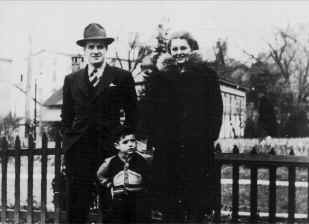
In 1935 he married his High School sweetheart, Jeanette Castor,and they had one son Peter born in 1936 and a daughter Claudia born in 1941. Bob was not happy in the local area and felt that he was not making the best use of his talents. Horn had a very baritone speaking voice with excellent phraseology, a personality that was immediately likable and an ability to fit in, in almost any situation or circumstance.
Moving to Camden, NJ in 1939 he worked in several local markets such as WIP and WPEN. Horn met and formed a working relationship with a local promoter named Nathan Segal. Together they staged many Jazz and Pop concerts most of the time using Horn as the MC and "On Air" promoter. Nat and Bob would become best friends and stayed that way until their deaths. Horn got his first big city announcing job in Philadelphia. By age twenty four Horn was a proven announcer in a multi-million population, major metropolitan area.
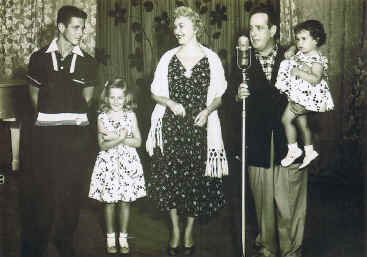
In 1946 he met Anna Davidow at the Latin Casino, a Philadelphia nightclub. Ann, a dancer with the Hacket Dance Troup, born and raised in Springfield, Mass. had recently returned from the South Pacific where she did a tour with the USO, Carl Reiner show using the stage name "Linda Stevens". Ann would later abandon dancing and make her debut as a singer at the Manor Hotel in Wildwood, N.J. Bob was growing impatient with his rise in the local markets so he accepted a job in Los Angeles as a newscaster. He and Ann moved to LA where they were married in Encenada or Rosarita, Mexico in 1946. The owner of the LA station was charged in some legal matter and Bob and Ann returned to Philadelphia in 1947 and moved into a Brownstone in South Philadelphia. Back in Philadelphia Horn went to work for WIP, where he worked as an announcer with Jim McKay and Jack Whitaker.
His late night radio show C'mon and Dance was one of the top in the Philadelphia market. His easy soft style and knowledge of the music made him an instant success. It was now, the seed started to grow. "How to introduce records to a TV audience in an interesting and entertaining way". Horn's first try at TV was on a Game show called Laugh, Grin and Giggle, sponsored by Baloney Bubble Gum. The show was short-lived but did supply the family with all the bubble gum they could chew.
The Horns were now living back in Camden and Ann was pregnant with their first daughter Marianne. Bob continued to lay the ground work for what he considered music's debut to TV, pulling together all the known success such as the Grady and Hurst 950 club, Snaders and marketed film clips by various stars. After the birth of their daughter, Bob and the family moved to Beverly, New Jersey.

In the late 40s Horn was hired by Jack Steck, Program Manager for WFIL-Radio stations, to be a daytime announcer and late night DJ for Walter Annenbeger's Triangle Publications' WFIL-AM radio. Triangle Publications also owned the Philadelphia Inquirer, the Daily Racing Form, other radio stations and a television station WFIL-TV. While Horn was there TV-Guide and Seventeen Magazine would be added to the Annenberg publishing and entertainment empire.
Horn was now commuting daily to Philadelphia to his new job at WFIL and his new radio show, Bob Horn's Bandstand. Bob was entering the TV market by now with a show which featured films of various stars performing and with Bob's knowledge of the subject material it flowed rather well,but still was not very successful. Horn even tried some segments with his wife Ann but she lacked his ability to ad-lib and the show soon folded.
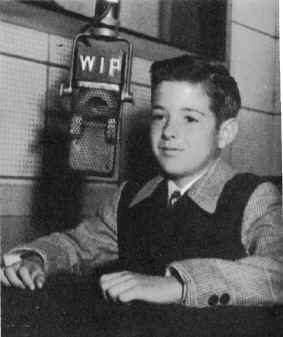
Peter Horn age 10 - 1940
Photo courtesy Peter Horn
One Saturday morning over breakfast, Bob asked his son Peter,then 15,if he thought his friends would travel to Philadelphia to be on a TV show where they could dance and maybe see their favorite music stars? This would be the first shot in what would become Television history. Horn had figured it out and Bob Horn's Bandstand for TV was born. All that remained was to convince station personnel it would work. Bob took his idea to WFIL management. Immediately realizing what Bob Horn was onto the management at WFIL was very receptive since Bandstand was now the most popular radio show in Philadelphia during that time slot and bringing that name and format to TV almost guaranteed an audience. Horn always had an ability to know or sense what music kids were into and an ability to relate to teens and their wants. Bob Horn's Bandstand premiered on October 7, 1952. It had a few growing pains as far as scheduling was concerned, but it caught on like wildfire in the Philadelphia area and later the entire metropolitan area.
|
|
In mid-summer 1952 station owner Walter Annenberg, looking to increase afternoon viewership, suggested to Roger Clipp Triangle Publications' radio and television stations manager and George Koehler WFIL-TV manager that they try a dance program aimed at teenagers.

Joe Grady and Ed Hurst
Turned down by Grady and Hurst, Clipp and Koehler, gradually eliminating other station's personnel, brought them to Bob Horn who had three year record at the station as a proven audience builder announcer and disk jockey. Also by that time Horn had some TV experience under his belt.
|
|
One week before the Fall school year was to begin for Philadelphia's public and parochial schools Horn was called into George Koehler's office. At that meeting Horn was asked to moved his Bob Horn's Bandstand radio program over to television. The show was to be aired afternoons Monday through Friday. It came with some stipulations one being that Horn would have a co-host Lee Stewart. Lee Stewart was a local radio personality who had one account, Muntz TV. He was on every radio station in town for Muntz, selling TV sets for $ 129.95 apiece. He'd do an hour show with the commercials jammed together and bits of records in between, so there'd be more commercials than records. Stewart sold Muntz TV's by the truckload and was respected a sasuper radio pitchman. Having Stewart as a co-host would bring the show its first sponsor Mad Man Muntz who Stewart had sold television sets for.
The other being that besides whatever guests Horn could line up, only a few records were to be played interspersed with Snaders and Officials film clips, the 50s version of today's music videos. The difference between then and today was that Snaders and Officials were unimaginable and poorly produced.
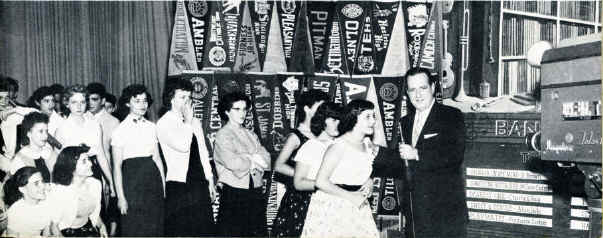
Bob Horn's Bandstand began it's two week trial run the last week of September through the first week of October in the afternoon s 2:30 to 4:30. The show bombed.
It was soon decided that the videos were to be eliminated. It's not known whose idea it was, but it was decided to take from the The 950 Club's format the inviting of high school kids into the studio while they were on the air. Time was to be allocated to interview the kids - find out their names, schools they attended, hobbies, and let them dance as the music played.
For a short time the station began running old movies as it prepared for the new version of Bob Horn's Bandstand that had the teenagers dancing as Horn played his choice of records.

On September 28, 1952 it was decided that the new show would premier Tuesday afternoon, October 7, 1952. Despite the fact that three area high schools - West Philadelphia High, West Catholic High for Girls, and West Catholic for Boys was within walking distance of the studio the station began a heavy promotional campaign. Immediately they began hyping the show on their AM and FM radio stations and editorially in the Philadelphia Inquirer which was own by Annenberg's Triangle Publications. Press releases were sent out to every media outlet in the greater Philadelphia.
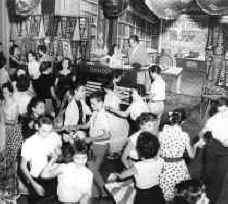
At 2:45 p.m. October 7, 1952 Bob Horn's Bandstand went on the air 15 minutes after West Catholic High School for Girls that was located just around the corner from the studio let out. However, it wasn't until 3:00 p.m. that the two first girls showed up. By 3:10 p.m there were twenty one teenagers. By the end of the third day there were a 1000 kids trying to get into a studio that could only hold 250. Horn quickly realized that the kids were the real stars of the show.

Shortly there after a committee of regulars was set up of 25 girls and 15 boys. These were teenagers that could be counted on to show rain, sleet, snow or shine. By doing this the show was guaranteed dancers for every show.

L to R: Horn: promoter Henry Finfer and
Tony Mamarella.
Mamarella would go on to become Dick Clark's producer
In the beginning of 1953 the show's airtime was increased to an hour and forty-five minutes. There was also talk in the Philadelphia area of network interest in the show.
That spring the show began starting at 2:45 P.M. to coincide with the dismissal of the area's nearby high schools.
|
|
During the early years the music that was danced to was primarily sung by white pop singers and the early guests were Joni James, Georgia Gibbs, Frankie Laine, et.al.

While these pop stars may have use Bandstand to promote their records the teenagers were more interested in dancing. From its beginning the show spawned many dance crazes the first which was inspired by Ray Anthony's "Bunny Hop".

To commemorate the shows second anniversary Bob Horn's Bandstand received a people's choice for 1954 TV Guide award.

Horn and Regulars at the Rate-A-Record
Desk 1953
Photo courtesy Peter Horn
With a highly successful show, with a waiting line of sponsors, Lee Stewart's Mad Man Muntz account was no longer that important. In 1955 Lee Stewart was let go and Horn became the show's sole host.
Bob Horn and Lois Gardner had known each other for two years. Gardner a tiny brunette, who looked older than her years, claimed to have been a member of Paul Whiteman's Teen Club before becoming a regular visitor to WFIL-TV's studio in 1952. She would allege that only one week after meeting Horn in the summer of 1953 they drove to his apartment where they engaged in a "discussion". In November she said that she and Horn, a married man with three young daughters and an adolescent son, began having sexual relations -when she was still thirteen - after which these encounters occurred once or twice a week until the end of 1955.
Horn told a different story claiming he had noticed Gardner at WFIL's studio, but didn't speak with her until sometime in 1954 when she appeared at his office, introduced herself and asked to appear on Bandstand. Horn told her that her request wasn't possible. Horn then went on describe her as what would today be call a groupie and denied ever having sex with her.
In 1956 Philadelphia District Attorney commenced an undercover investigation into a suspected vice ring that it was believed preyed on teenage girls. The ring used promises of modeling careers to lure them into pornographic photo sessions and orgies at Hound Dog Hill, a country estate north of Philadelphia. Lois Gardner was suspected of being involved with the ring.


During the early hours of June 21, 1956 Horn was pulled over by police after running a red light. He's was taken to the local police station where he found to be drunk and was given a ticket for running a red light and arrested for drunken driving.
With the Philadelphia Police Department carrying on a month long campaign against drunk drivers, which Annenberg's Philadelphia Inquirer had championed, WFIL suspended Horn from Bandstand and named Tony Mammerella, the show's producer, temporary host.
During this time Horn went on an extended vacation after which he was subsequently offered and turned down the position of Music Director.
On November 8, 1956 Horn was indicted on four four statutory rape charges and four charging corruption of the morals of a minor. The first trial ended in a hung jury.The family found the whole issue to be quite strange since there was an attempt at extortion. For a considerable amount of money the plaintiff would drop the charges. The prosecution knew of the attempt. The money was actually prepared and a delivery attempted yet the trial continued. The second trial ended with a not guilty verdict.

Protesting Horn's firing.
Jerry Blavat is fellow in center front row holding sign
"I arrived home on Friday night to find the house packed with lawyers and some rather rough looking people. On the kitchen table was a pile of money, the most I'd ever seen in my life. My Dad had been contacted by the girls representatives who said that a $5000.00 payoff would get her out of town. As I remember, Jerry Blavit was asked to deliver the money, or she requested that he do so. It was felt by all that this was complete vindication for my Dad. The attempt was made and witnessed by the prosecution and why all charges were not dropped and why she wasn't charged I have no idea" ...... Peter Horn October14, 2003

Also, on the day of his indictment, Horn was involved in an accident. It seems that Horn was driving the wrong way down a one way street when he hit another car in which a little girl in the other car was seriously injured. Horn was arrested and cited as being drunk. He was taken to the police station where a police surgeon on duty tested him, Horn by his own admission had had two beers) and found him to be intoxicated, but not enough to prevent him from driving safely. Found to be guilty Horn's insurance company paid $100,000 in claims to the family and owner's of two parked cars that were damaged as a result of the family's car being pushed into them.
|
|
|
These three incidents effectively ended Horn's career in Philadelphia
A tired and broken Horn left his beloved Philadelphia in July 1957 moving to to Houston, Texas where he took a job with radio station KILT hosting a news-talk-music radio show. At this time he changed his name to Bob Adams

Horn's Eastern personality and style wasn't right to be a hit among Texas radio listeners He was soon taken off the air and became an advertising representative for the station. Later, he would open up his own advertising agency Bob Adams Associates in Houston, Texas which would be the creator of the first "Midnight Madness Sale." He also owned a lounge known as the Town & Country in Bellaire, Texas.
During this time Horn returned to Philadelphia for his court trials and to serve three months of a jail sentence upon losing his appeal of one of the DWIs.
|
|
On July 31, 1966 while mowing his lawn, Bob Horn had a heart attack brought on by heat stroke. He is buried at the Forest Park cemetery in Houston, Texas with the simple epitaph, "Bandstand". He was only 50 when he passed away.
Side Note
This year Peter traveled to New Jersey for a scheduled vacation and went to a dance hosted by Philadelphia's most popular DJ, Jerry Blavat. Jerry introduced Peter as Bob's son and there was an instantaneous applause from the crowd. Let no one doubt what that was about or who it was for. After, an older gentleman approached Peter and simply said, "We just loved your Dad". That said it all
Special thanks to Peter Horn for corrections and additions.
American Bandstand's Untold Story
Secret History of American Bandstand
![]()